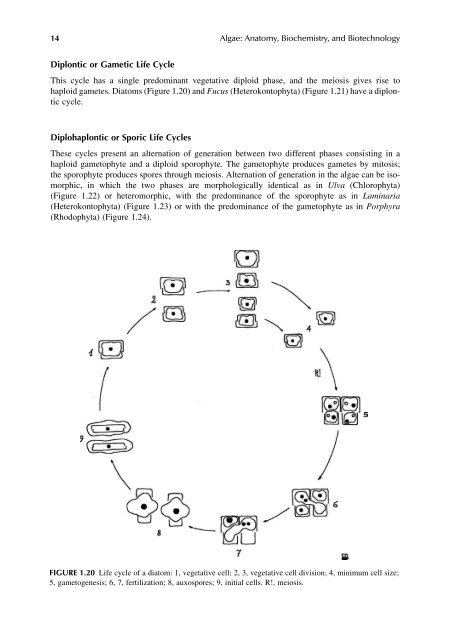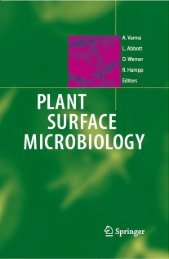- Page 2: Algae Anatomy, Biochemistry, and Bi
- Page 5 and 6: Published in 2006 by CRC Press Tayl
- Page 7 and 8: Our sincere gratitude and a special
- Page 10 and 11: Table of Contents Chapter 1 General
- Page 12 and 13: How Algae Use Light Information ...
- Page 14 and 15: Lambertian Surfaces . . ...........
- Page 16: In memory of Maria Antonietta Barsa
- Page 19 and 20: 2 Algae: Anatomy, Biochemistry, and
- Page 21 and 22: 4 Algae: Anatomy, Biochemistry, and
- Page 23 and 24: 6 Algae: Anatomy, Biochemistry, and
- Page 25 and 26: 8 Algae: Anatomy, Biochemistry, and
- Page 27 and 28: 10 Algae: Anatomy, Biochemistry, an
- Page 29: 12 Algae: Anatomy, Biochemistry, an
- Page 33 and 34: 16 Algae: Anatomy, Biochemistry, an
- Page 35 and 36: 18 Algae: Anatomy, Biochemistry, an
- Page 37 and 38: 20 Algae: Anatomy, Biochemistry, an
- Page 39 and 40: 22 Algae: Anatomy, Biochemistry, an
- Page 41 and 42: 24 Algae: Anatomy, Biochemistry, an
- Page 43 and 44: 26 Algae: Anatomy, Biochemistry, an
- Page 45 and 46: 28 Algae: Anatomy, Biochemistry, an
- Page 47 and 48: 30 Algae: Anatomy, Biochemistry, an
- Page 49 and 50: 32 Algae: Anatomy, Biochemistry, an
- Page 51 and 52: 34 Algae: Anatomy, Biochemistry, an
- Page 53 and 54: 36 Algae: Anatomy, Biochemistry, an
- Page 55 and 56: 38 Algae: Anatomy, Biochemistry, an
- Page 57 and 58: 40 Algae: Anatomy, Biochemistry, an
- Page 59 and 60: 42 Algae: Anatomy, Biochemistry, an
- Page 61 and 62: 44 Algae: Anatomy, Biochemistry, an
- Page 63 and 64: 46 Algae: Anatomy, Biochemistry, an
- Page 65 and 66: 48 Algae: Anatomy, Biochemistry, an
- Page 67 and 68: 50 Algae: Anatomy, Biochemistry, an
- Page 69 and 70: 52 Algae: Anatomy, Biochemistry, an
- Page 71 and 72: 54 Algae: Anatomy, Biochemistry, an
- Page 73 and 74: 56 Algae: Anatomy, Biochemistry, an
- Page 75 and 76: 58 Algae: Anatomy, Biochemistry, an
- Page 77 and 78: 60 Algae: Anatomy, Biochemistry, an
- Page 79 and 80: 62 Algae: Anatomy, Biochemistry, an
- Page 81 and 82:
64 Algae: Anatomy, Biochemistry, an
- Page 83 and 84:
66 Algae: Anatomy, Biochemistry, an
- Page 85 and 86:
68 Algae: Anatomy, Biochemistry, an
- Page 87 and 88:
70 Algae: Anatomy, Biochemistry, an
- Page 89 and 90:
72 Algae: Anatomy, Biochemistry, an
- Page 91 and 92:
74 Algae: Anatomy, Biochemistry, an
- Page 93 and 94:
76 Algae: Anatomy, Biochemistry, an
- Page 95 and 96:
78 Algae: Anatomy, Biochemistry, an
- Page 97 and 98:
80 Algae: Anatomy, Biochemistry, an
- Page 99 and 100:
82 Algae: Anatomy, Biochemistry, an
- Page 101 and 102:
84 Algae: Anatomy, Biochemistry, an
- Page 103 and 104:
86 Algae: Anatomy, Biochemistry, an
- Page 105 and 106:
88 Algae: Anatomy, Biochemistry, an
- Page 107 and 108:
90 Algae: Anatomy, Biochemistry, an
- Page 109 and 110:
92 Algae: Anatomy, Biochemistry, an
- Page 111 and 112:
94 Algae: Anatomy, Biochemistry, an
- Page 113 and 114:
96 Algae: Anatomy, Biochemistry, an
- Page 115 and 116:
98 Algae: Anatomy, Biochemistry, an
- Page 117 and 118:
100 Algae: Anatomy, Biochemistry, a
- Page 119 and 120:
102 Algae: Anatomy, Biochemistry, a
- Page 121 and 122:
104 Algae: Anatomy, Biochemistry, a
- Page 123 and 124:
106 Algae: Anatomy, Biochemistry, a
- Page 125 and 126:
108 Algae: Anatomy, Biochemistry, a
- Page 127 and 128:
110 Algae: Anatomy, Biochemistry, a
- Page 129 and 130:
112 Algae: Anatomy, Biochemistry, a
- Page 131 and 132:
114 Algae: Anatomy, Biochemistry, a
- Page 133 and 134:
116 Algae: Anatomy, Biochemistry, a
- Page 135 and 136:
118 Algae: Anatomy, Biochemistry, a
- Page 137 and 138:
120 Algae: Anatomy, Biochemistry, a
- Page 139 and 140:
122 Algae: Anatomy, Biochemistry, a
- Page 141 and 142:
124 Algae: Anatomy, Biochemistry, a
- Page 143 and 144:
126 Algae: Anatomy, Biochemistry, a
- Page 145 and 146:
128 Algae: Anatomy, Biochemistry, a
- Page 147 and 148:
130 Algae: Anatomy, Biochemistry, a
- Page 149 and 150:
132 Algae: Anatomy, Biochemistry, a
- Page 151 and 152:
134 Algae: Anatomy, Biochemistry, a
- Page 153 and 154:
136 Algae: Anatomy, Biochemistry, a
- Page 155 and 156:
138 Algae: Anatomy, Biochemistry, a
- Page 157 and 158:
140 Algae: Anatomy, Biochemistry, a
- Page 159 and 160:
142 Algae: Anatomy, Biochemistry, a
- Page 161 and 162:
144 Algae: Anatomy, Biochemistry, a
- Page 163 and 164:
146 Algae: Anatomy, Biochemistry, a
- Page 165 and 166:
148 Algae: Anatomy, Biochemistry, a
- Page 167 and 168:
150 Algae: Anatomy, Biochemistry, a
- Page 169 and 170:
152 Algae: Anatomy, Biochemistry, a
- Page 171 and 172:
154 Algae: Anatomy, Biochemistry, a
- Page 173 and 174:
156 Algae: Anatomy, Biochemistry, a
- Page 175 and 176:
158 Algae: Anatomy, Biochemistry, a
- Page 177 and 178:
160 Algae: Anatomy, Biochemistry, a
- Page 179 and 180:
162 Algae: Anatomy, Biochemistry, a
- Page 181 and 182:
164 Algae: Anatomy, Biochemistry, a
- Page 183 and 184:
166 Algae: Anatomy, Biochemistry, a
- Page 185 and 186:
168 Algae: Anatomy, Biochemistry, a
- Page 187 and 188:
170 Algae: Anatomy, Biochemistry, a
- Page 189 and 190:
172 Algae: Anatomy, Biochemistry, a
- Page 191 and 192:
174 Algae: Anatomy, Biochemistry, a
- Page 193 and 194:
176 Algae: Anatomy, Biochemistry, a
- Page 195 and 196:
178 Algae: Anatomy, Biochemistry, a
- Page 197 and 198:
180 Algae: Anatomy, Biochemistry, a
- Page 199 and 200:
182 Algae: Anatomy, Biochemistry, a
- Page 201 and 202:
184 Algae: Anatomy, Biochemistry, a
- Page 203 and 204:
186 Algae: Anatomy, Biochemistry, a
- Page 205 and 206:
188 Algae: Anatomy, Biochemistry, a
- Page 207 and 208:
190 Algae: Anatomy, Biochemistry, a
- Page 209 and 210:
192 Algae: Anatomy, Biochemistry, a
- Page 211 and 212:
194 Algae: Anatomy, Biochemistry, a
- Page 213 and 214:
196 Algae: Anatomy, Biochemistry, a
- Page 215 and 216:
198 Algae: Anatomy, Biochemistry, a
- Page 217 and 218:
200 Algae: Anatomy, Biochemistry, a
- Page 219 and 220:
202 Algae: Anatomy, Biochemistry, a
- Page 221 and 222:
204 Algae: Anatomy, Biochemistry, a
- Page 223 and 224:
206 Algae: Anatomy, Biochemistry, a
- Page 226 and 227:
6 Algal Culturing COLLECTION, STORA
- Page 228 and 229:
Algal Culturing 211 TABLE 6.1 Shape
- Page 230 and 231:
Algal Culturing 213 maintenance of
- Page 232 and 233:
Algal Culturing 215 tissue culture
- Page 234 and 235:
Algal Culturing 217 TABLE 6.2 BG11
- Page 236 and 237:
Algal Culturing 219 TABLE 6.5 Aaron
- Page 238 and 239:
Algal Culturing 221 TABLE 6.7 Beije
- Page 240 and 241:
Algal Culturing 223 TABLE 6.9 Mes-V
- Page 242 and 243:
Algal Culturing 225 MARINE MEDIA Se
- Page 244 and 245:
Algal Culturing 227 reactions. Of t
- Page 246 and 247:
Algal Culturing 229 TABLE 6.11 Waln
- Page 248 and 249:
Algal Culturing 231 TABLE 6.14 PCR-
- Page 250 and 251:
Algal Culturing 233 TABLE 6.17 ESAW
- Page 252 and 253:
Algal Culturing 235 . CSIRO (CSIRO
- Page 254 and 255:
Algal Culturing 237 extended period
- Page 256 and 257:
Algal Culturing 239 In practice, cu
- Page 258 and 259:
Algal Culturing 241 SEMI-CONTINUOUS
- Page 260 and 261:
Algal Culturing 243 around the worl
- Page 262 and 263:
Algal Culturing 245 tech,” and ca
- Page 264 and 265:
Algal Culturing 247 FIGURE 6.3 Sche
- Page 266 and 267:
Algal Culturing 249 Digital microsc
- Page 268 and 269:
7 INTRODUCTION Algae and Men Microa
- Page 270 and 271:
Algae and Men 253 of cattle is rapi
- Page 272 and 273:
Algae and Men 255 FIGURE 7.2 Drying
- Page 274 and 275:
Algae and Men 257 for equally valua
- Page 276 and 277:
Algae and Men 259 thickening powers
- Page 278 and 279:
Algae and Men 261 FIGURE 7.6 Frond
- Page 280 and 281:
Algae and Men 263 FIGURE 7.7 Frond
- Page 282 and 283:
Algae and Men 265 TABLE 7.3 Mineral
- Page 284 and 285:
Algae and Men 267 sporophyte. Spore
- Page 286 and 287:
Algae and Men 269 naturally found i
- Page 288 and 289:
Algae and Men 271 so that water and
- Page 290 and 291:
Algae and Men 273 FIGURE 7.13 Frond
- Page 292 and 293:
Algae and Men 275 and some fish spe
- Page 294 and 295:
Algae and Men 277 Because Ascophyll
- Page 296 and 297:
Algae and Men 279 Maerl is the comm
- Page 298 and 299:
Algae and Men 281 THERAPEUTIC SUPPL
- Page 300 and 301:
Algae and Men 283 in globules in ot
- Page 302 and 303:
Algae and Men 285 supplement due to
- Page 304 and 305:
Algae and Men 287 epiphyte and has
- Page 306 and 307:
Algae and Men 289 closely-related P
- Page 308:
Algae and Men 291 Takeyama, H., Kan
- Page 311 and 312:
294 Index Carbohydrate storage prod
- Page 313 and 314:
296 Index Endosymbiosis, serial sec
- Page 315 and 316:
298 Index Motility about, 85 buoyan
- Page 317 and 318:
300 Index Redfield ratio, 161-162 R



